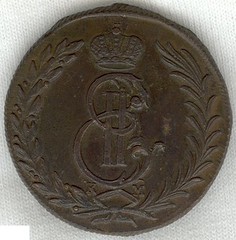
PREV ARTICLE
NEXT ARTICLE
FULL ISSUE
PREV FULL ISSUE
MORE ON THE FT. ROSS, CALIFORNIA SOUVENIR TOKEN
Steve D'Ippolito submitted these thoughts on the Fort Ross souvenir pieces discussed last week. Thanks!
-Editor

I've been asked about the Fort Ross "coins" on a couple of occasions as well. The story you quoted is correct. The original 5 kopek Siberian piece is very thick, compared to the token. Even without the Ft. Ross add-on, it would be an obvious fake. Well, obvious to anyone who had ever owned an original, anyway. When I actually visited Fort Ross and saw the things for sale, they looked wrong from three feet away. Probably further away than that, but that's how close I was when I spotted them. Whoever brought the original coin to Fort Ross was carrying a much older and technically demonetized piece, so I've always wondered how that coin got there in the first place. The Siberian series was minted near present day Barnaul (not too far from where Kazakhstan, Russia, China, and Mongolia almost form a Four Corners, in the Altai region) in a town called Suzun (Сузун) from 1764-81 in part because it was difficult to send other money there. The copper used was a byproduct of a silver mine in Kolyvan (Колыван), and because of the less-advanced processing of the day, still contained some silver in it. Russia decided to make coins out of the copper, solving two problems at once. Because of the silver impurity, the coins were minted to a lower weight standard than other coppers of the time, and had a distinctive (and much more interesting) design as a consequence. You've all seen those large copper five kopek pieces of Catherine the Great; the Fort Ross token was based on a coin that is also a five kopek piece made contemporaneously, but is somewhat smaller. The letters KM seen on the post 1766 pieces below the script E are not a mint mark; they stand for Kolyvanski Med' (Kolyvan Copper). (That phrase is edge lettered on the early, rarer dates). When I sold the vast majority of my Russian Imperial holdings, I hung on to a ten kopek Siberian piece. Eventually the mine got better at extracting all of the silver and the mint that had been built there started producing standard design/standard weight copper pieces in 1782, with the Suzun mintmark, СМ. (So if you find one of those big five kopek pieces with that mintmark, it's the same place that previously produced the Siberian pieces. It will also be worth more than the much more common ЕМ mintmark, which must be about R minus sixteen.) The Siberian pieces were officially demonetized. And someone carried one the rest of the way across Siberia and brought it to Fort Ross, only to lose it. Perhaps the coins still circulated in Siberia (they were never legal tender anywhere else in Russia) even after they were demonetized. After all, probably no one within a thousand miles cared.


The diameter of the five kopek Siberian copper (shown above) is about 35 mm (not struck in collar so it varies), weight 33 grams. Note that the weight and diameter are very similar to those of a US double eagle, but this is only copper, which gives you an idea of the thickness. Denominations for the series ranged from polushka (1/4 kopek) to ten kopeks. The ten kopek piece is about 44-45mm, and weighed about 65 grams. It's noticeably larger than those ubiquitous regular issue five kopek coppers, which were 50 grams, diameter approximately 41mm. (I occasionally exhibit my ten kopek Siberian as part of "Russian Coins of Conquest.") The inscription encircling the sables reads "Siberian Coin," the lettering on the shield reads "Five Kopeks". The script E II on the other side is for Ekaterina II, Catherine the Great. The edge is a slant reed /////// (except in the early years of the larger denominations where an edge inscription reads "Kolyvan Copper" and the KM letters do not appear).
To read the earlier E-Sylum article, see:
THE FT. ROSS, CALIFORNIA SOUVENIR TOKEN
(www.coinbooks.org/esylum_v17n25a16.html)
The Numismatic Bibliomania Society is a non-profit organization promoting numismatic literature. See our web site at coinbooks.org. To submit items for publication in The E-Sylum, write to the Editor at this address: whomren@gmail.com To subscribe go to: https://my.binhost.com/lists/listinfo/esylum All Rights Reserved. NBS Home Page Contact the NBS webmaster 
|